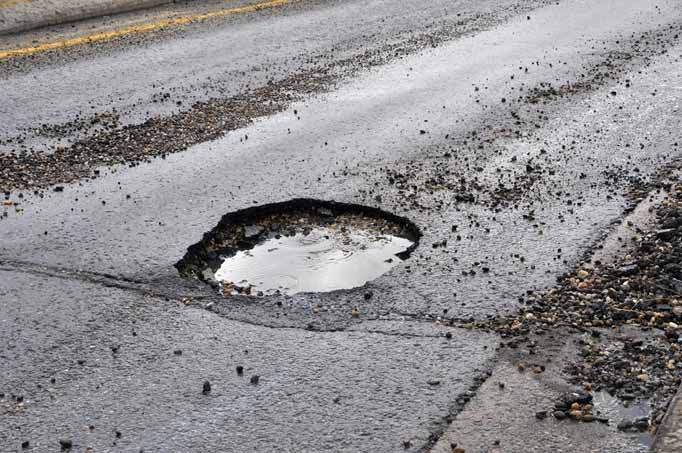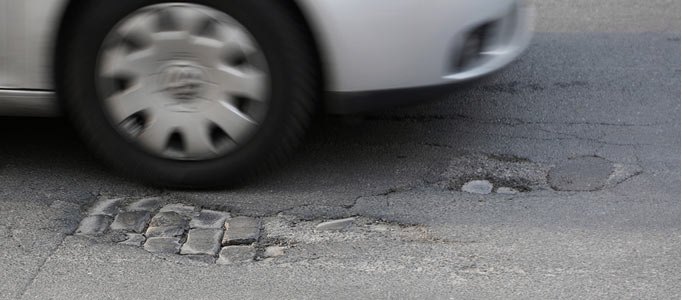Winter is here and so are the potholes
With the winter season upon us, attention will once again turn to the somewhat awful condition of the nation’s roads. The announcement of a new road fund scheme from the government will be too little too late for many drivers this season. Pot holes are a particular menace, seeming to pop up everywhere, including the M25 where massive disruption caused by potholes recently brought the motorway to a standstill. The winter weather and possibility of heavy rainfall will only make the situation worse. So what can you do if your car is damaged by a pothole?
What causes a pothole?
A pothole is caused when water enters a crack in the road and freezes, expanding and cracking the tarmac. In recent years the level of rainfall experienced across the country has risen dramatically. Combined with the seasonal cold weather means potholes are becoming more and more common.
Another issue is the current funding crisis local councils are experiencing, meaning budgets are tightened and costs have to be cut. This has affected the amount of money available for road repairs, and when potholes are repaired, it is often a quick fix rather than a thorough repair. This often leads to the repairwork becoming quickly undone.
What damage can a pothole cause?
Every driver knows that feeling. The big bump when you unwittingly drive over a previously unseen pothole. That sudden loud bang. The wince as the car jerks suddenly. And that scary few moments afterwards, where you wonder just how much damage has been done?
Thankfully, most times you drive over a pothole the damage is minimal. But potholes can cause some major damage:
- Buckled tyres
- Cracked alloys
- Punctures
- Damage to wheel tracking
- Damage to wheel balancing
- Broken wishbone
- Damaged wheel arch
If you feel a change in the way your car drives after hitting a pothole, you should stop when you can to check the vehicle.

How to claim if your car is damaged by a pothole
Damage to your car can be a major nuisance, especially when its caused by a pothole. You may be wondering what you can do, maybe even wondering if it was your own fault for driving over the pothole. According to the government highways agency website, you will need to prove that the damage occurred on a road or highway. If it was a motorway or trunk road, the responsibility lies with the highways agency. If it was on a smaller road, you will need to find the local authority responsible for managing the road. You can find out who manages which road using a post code and the highways agency website.
Below are the four items of information listed on the gov.uk website that you require to claim for damage on your vehicle.
- What the damage was.
- Why you think the Highways Agency is responsible.
- The specific location where the damage took place – the road name and the nearest marker post number or feature which identifies the part of the road you were on.
- The date and time the damage was caused.
Using these points as a guideline, here are the steps you should take once your car has been damaged.
First: Write down the time and date. Getting this out of the way will save you having to try and remember later.
Second: Work out the location of the pothole. If you are on a road, look for the nearest junctions, so you can position the pothole accurately. If you are on a motorway, it may be more tricky to find the nearest marker. Drive or walk (if it is safe to do so) and find the nearest road marker. These are spaced on motorways every 100 metres. If there aren’t any markers, look for a side road or nearby business to use as a reference.
Third: Photograph the pot hole. Again, make sure it is safe to do so and that you won’t distract any traffic. You must not do this on the motorway. Try to get an idea of the scale of the pothole, as well as its location in respect to the road.
Fourth:Take your car to a garage or mechanic and have them assess the damage. Have them write down a list of what damage has occurred and what the repairs will cost. Have them take photos of the damage caused.
Now that you have these pieces of information, you have all the details you need when making a claim. You will now need to visit the gov.uk website and download a damage report form. You will have to complete the form and send it off to the Highways Agency, along with a copy of your most recent MOT and all the information you have collected previously.
The decision will come within 90 days. In the meantime, you may have to get the damage repaired out of your own pocket. However, if you have followed all the steps then you should have no problem getting your claim considered. If your claim is rejected, you may wish to consider using the Small Claims Court to get your compensation. It would be best to get some legal advice before pursuing this course of action.
Should I report potholes when I see one?
With the number of potholes growing higher and higher, it might seem like a losing battle when it comes to reporting. If you feel that a particular pothole has not been dealt with for a long time, you can report via the government website.





 Facebook
Facebook Twitter
Twitter Instagram
Instagram LinkedIn
LinkedIn Youtube
Youtube